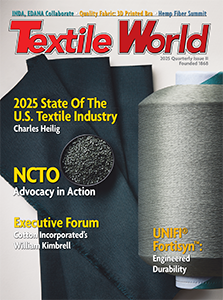 By James M. Borneman, Editor In Chief
By James M. Borneman, Editor In Chief
It’s great to have a strong economic headline to start a year that holds such promise, despite facing a stormy international business undercurrent.
The first of the year Institute for Supply Management “Manufacturing ISM® Report On Business®”reported a Manufacturing Purchasing Managers Index (PMI®) of 50.9 percent — great news for U.S. manufacturers.
Even better is the fact that the textile mills sector led the charge of manufacturing sectors reporting expansion. Any Manufacturing PMI report at 50-percent or above signals expansion and this is the first report at that level after 26 consecutive months of contraction.
Eight manufacturing sectors reported growth in January — all good company at the industrial core of U.S. manufacturing.
That said, the strength and impact of a stormy international business undercurrent caused by the new administration’s bold tariff rhetoric is the great unknown.
The Global Port Tracker report released by the National Retail Federation and Hackett Associates described the uncertainty without alarm. “At this stage, the situation is fluid, and it’s too early to know if the tariffs will be implemented, removed or further delayed,”said Hackett Associates Founder Ben Hackett.“As such, our view of North American imports has not changed significantly for the next six months.”
No sooner had President Donald J. Trump announced 25 percent tariffs on Canadian and Mexican imports, they were paused for one month based on Canadian and Mexican support for assistance with illegal immigration and fentanyl interdiction at the respective borders.
It would seem at this writing that China is also facing increased tariffs and the suspension the de minimis exemption for shipments originating from China. Also on the block
is the $800 duty-free threshold for Chinese imports. It would appear that all goods from China, regardless of value, will be subject to formal customs processing and tariffs. Aside from that, a new 10 percent tariff looks like it will be imposed on all Chinese imports, in addition to existing duties.
This is a big swing in international commerce that could carry significant impacts on a broad range of businesses, including textiles.
Without getting in the weeds, the de minimis exemption was a customs accommodation for small packages, of little value, shipped internationally into the United States. An individual could receive a bottle of Scotch from an aunt in Scotland at Christmas without clearing customs and paying duty. Unfortunately, that accommodation became a loophole, then expanded to a loophole-based industry.
National Council of Textile Organizations (NCTO) President and CEO Kim Glas has been extremely active in supporting closing the de minimis exemption loophole. In mid-January she stated in a press release,“We have long called on the administration to use its existing authorities to mitigate the damage to our industry created by de minimis, which has functioned as a massive tariff loophole for low-cost, subsidized, and unethical Chinese imports.
“The U.S. textile industry … is experiencing severe demand destruction fueled by 4 million de minimis shipments a day flooding our market with cheap, often illegal imports because of this outdated trade provision that rewards Chinese e-commerce platforms, importers and tariff cheaters with an open door to the U.S. market.”
What a way to kick off 2025. Hold tight, the positive, stormy ride just started!
2025 Quarterly Issue I




